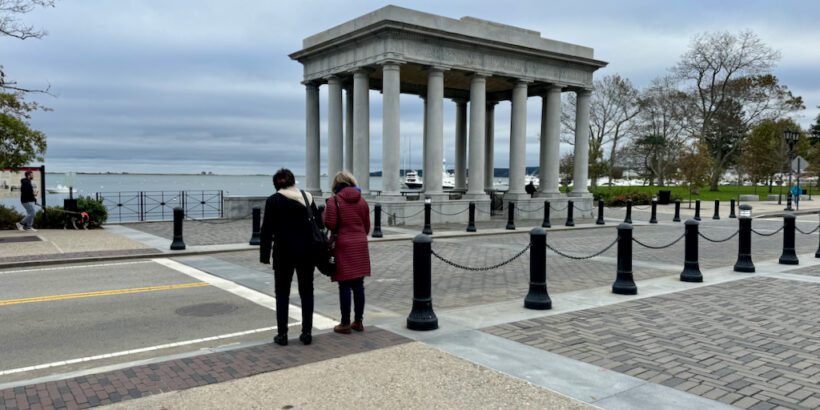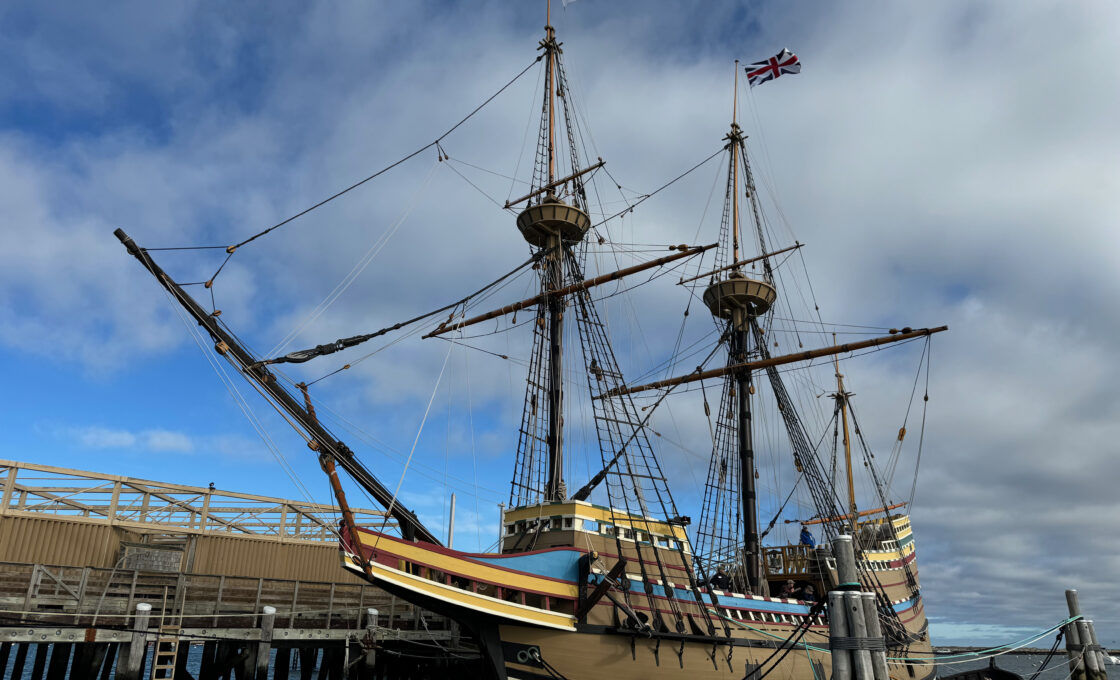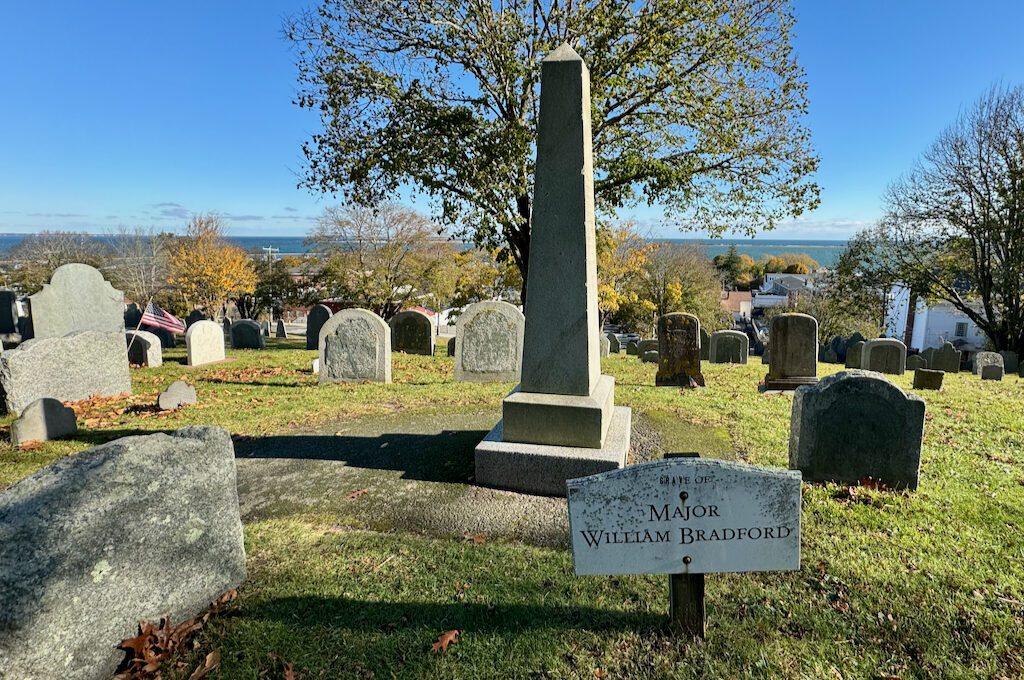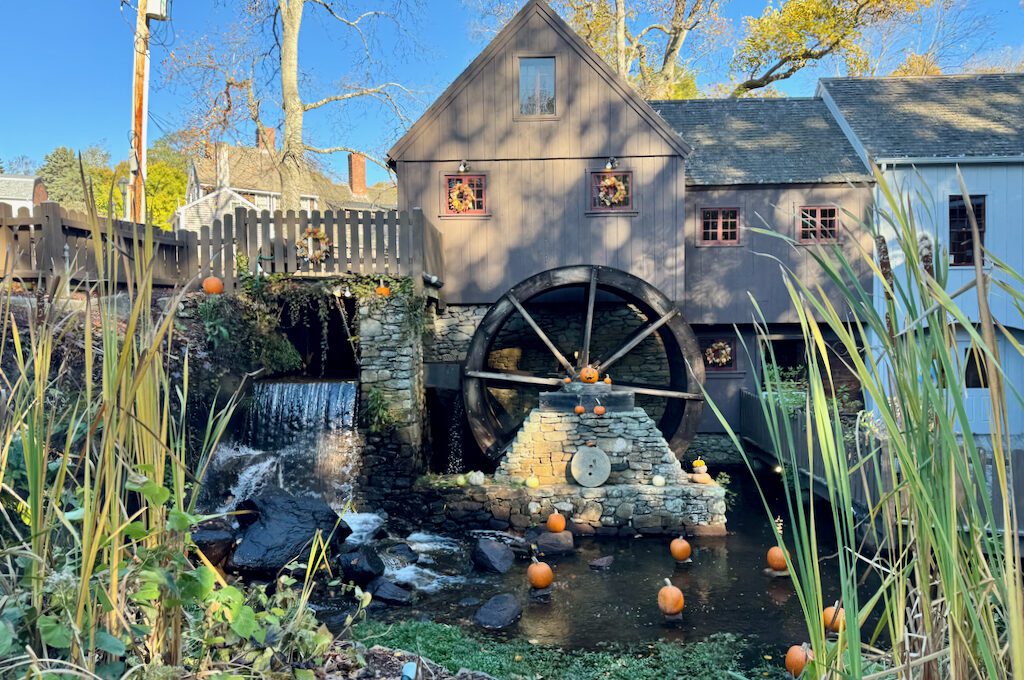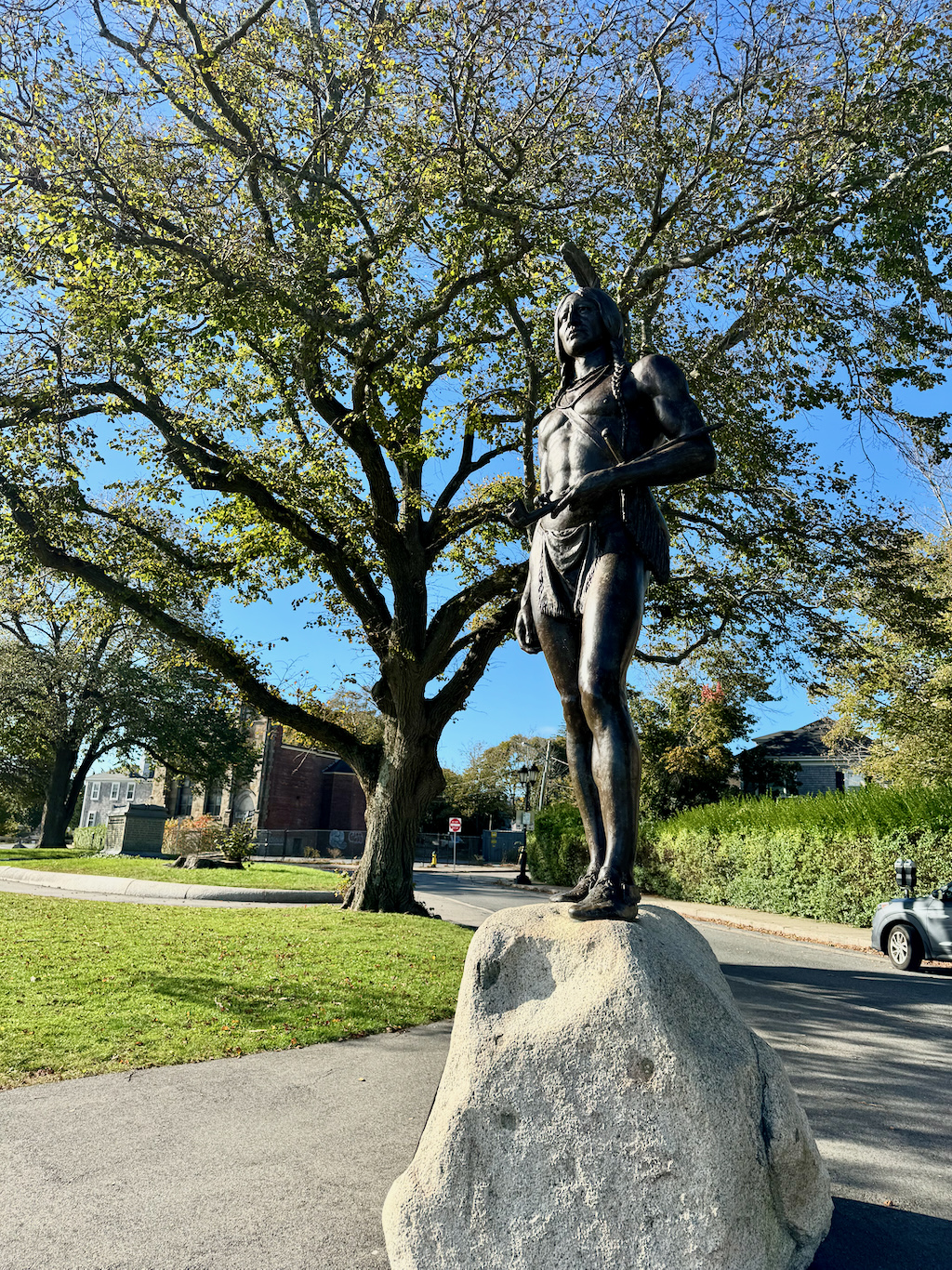Plymouth, Massachusetts, stands as an absolute must-visit for history enthusiasts, serving as the foundational site of colonization in New England and representing the inception of the first permanent English colony in the region.
While the town is teeming with historical treasures, a single day is insufficient to explore all its offerings. However, a few standout attractions demand attention and promise to provide a comprehensive glimpse into Plymouth’s captivating history.
During our recent visits to Plymouth, we had the opportunity to explore some of the city’s most frequented attractions.
Here, I’ll delve into the details of these must-see landmarks. Even with just one day, you should be able to cover these highlights, offering a rich and immersive understanding of the town’s fascinating past.
Table of Contents
Sample one-day itinerary
Before jumping into the details all of the sites, here is a sample itinerary you can use to help plan your own visit for a full day trip to Plymouth.
When exploring these sites in Plymouth, you can find both parking lots and street parking options. Keep in mind that some parking may be free, while others may have fees.
However, locating a parking spot shouldn’t be overly challenging, especially if you arrive in the morning, prepared for a full day of exploration.
Once you find parking pretty much all of the destinations below are within walking distance of each other although you will probably want to drive to the Plymouth Patuxet Museum.
| Attraction | Estimated Duration | Notes |
|---|---|---|
| Burial Hill | 30 minutes | Stroll through the cemetery, explore grave markers, and enjoy views of the harbor. |
| Statues and Monuments | 30 minutes | Explore various monuments and statues, including Coles Hill Burial Ground. |
| Plymouth Rock | 2 to 15 minutes | Despite its size, a visit offers historical context. Engage with interpretive rangers if available. |
| Mayflower II | 30 minutes | Explore the ship, learn about its historical significance, and interact with the knowledgeable staff. |
| Plymouth Grist Mill | 30 to 45 minutes | Tour the facility, engage with staff, and witness the workings of the mill. |
| Plymouth Patuxet Museum | 1 to 2 hours | Walk the trail, explore Wampanoag structures, and immerse yourself in the Pilgrim Village. |
| Enjoy a Local Restaurant | 1 hour | Savor Thai cuisine at Mea Thai Cuisine or indulge in burgers at KK Burgers. |
| Pilgrim Hall Museum | 1 to 2 hours | Navigate through historical exhibits and admire the collection of artifacts. |
| National Monument to the Forefathers | 15 minutes | Appreciate the granite tower and its allegorical figures. |
Plymouth Rock
Sure, Plymouth Rock often falls short of tourists’ expectations, and the reasons behind this sentiment are quite valid.
Firstly, its physical size is notably smaller than what many envision. Upon the initial glimpse, a common reaction is the disenchanted query, “Is that it?” It’s barely even a boulder!
Compounding the disappointment is the ambiguous history surrounding the rock.
The probability is high that it might not be the actual landing point of the pilgrims at Plymouth Harbor and it’s true that Provincetown was the first landing spot for the Pilgrims (although not all of the Pilgrims got off the ship there).
Despite these drawbacks, a visit remains worthwhile, because at the very least it gives you the opportunity to assess its merit as a tourist attraction firsthand.
During the summer or fall, you’ll likely encounter an interpretive ranger on-site, capable of shedding light on your inquiries regarding the rock and its historical context, which will hopefully allow your visit to be more than just a 60 second rock encounter.
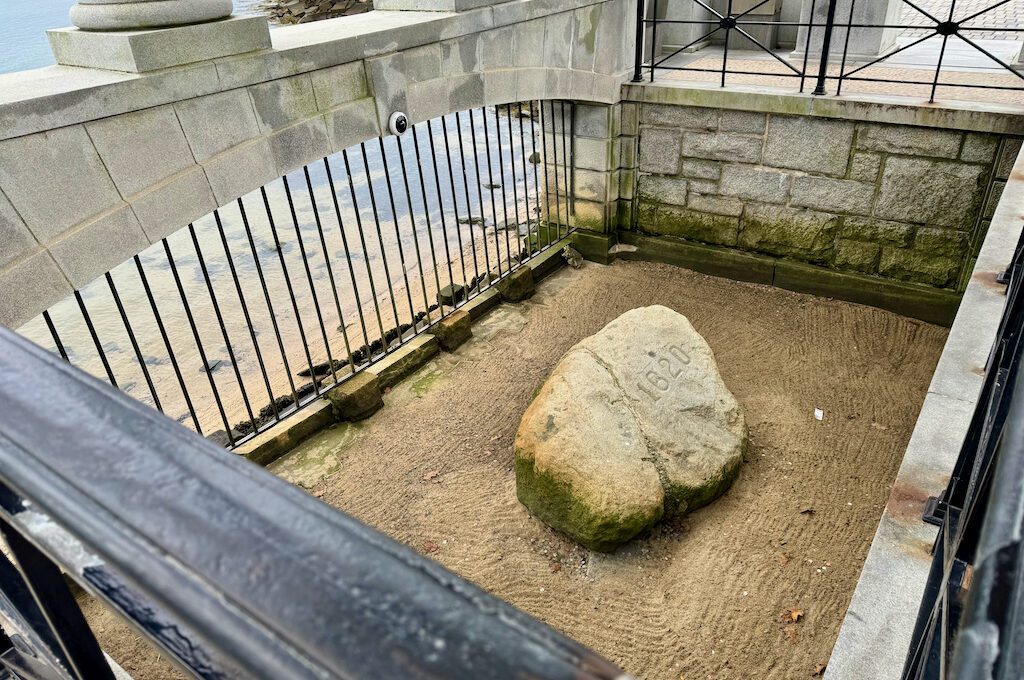
The Mayflower II
Adjacent to Plymouth Rock, the Mayflower II stands as a prominent attraction for visitors arriving in Plymouth. Serving as a faithful reproduction of the original Mayflower, it’s crucial to note that it’s not a mere replica due to the unavailability of the original blueprints.
Constructed in the 1950s, this ship holds historical significance as a symbol of the mutual support between the United States and the United Kingdom during WWII. Setting sail from Plymouth, England, in 1957, the Mayflower II traversed the Atlantic, reaching Plymouth, Massachusetts, on June 22, 1957.
Stepping on board provides a captivating experience, offering a tangible sense of the cramped living quarters that accommodated over 100 pilgrims during their journey to the New World. The knowledgeable interpretive staff on site is adept at addressing a myriad of questions about the pilgrims, enhancing the overall visit.
Due to its modest size, the ship offers a limited array of attractions, and your visit may be relatively brief. To maximize your experience, I recommend actively engaging with the staff members. Their insights can offer a deeper understanding of the ship’s history and intricacies, turning a brief visit into a rich educational opportunity.
Burial Hill
Burial Hill stands as the inaugural official cemetery of the Pilgrims, its establishment dating back to 1622. While not the initial burial grounds, it holds the distinction of being the first officially designated cemetery. Here lie the resting places of numerous early pilgrims, among them the notable figure, William Bradford.
Additionally, this site is the location of the original fort erected by the Pilgrims and marks the founding location of the original colony, rendering it an immensely historic locale.
Despite the biting cold on the day of our visit, exploring Burial Hill proved to be a captivating experience. The grave markers, each with its own story, added an intriguing dimension to the chilly atmosphere.
The special markers designating the resting places of the original pilgrims ensure they are easily distinguishable, making the stroll through the cemetery a poignant journey through history. Amidst the graves, one can also take in the breathtaking views of the harbor.
Plymouth Patuxet Museum
The Plymouth Patuxet Museum stands as a beautiful recreation of a seventeenth-century Pilgrim village, representing a key highlight of Plymouth’s historical legacy.
Spanning a substantial area, the site features a museum housing a treasure trove of captivating artifacts from the era. Upon arrival, visitors are guided along a trail, affording glimpses of intriguing Wampanoag structures.
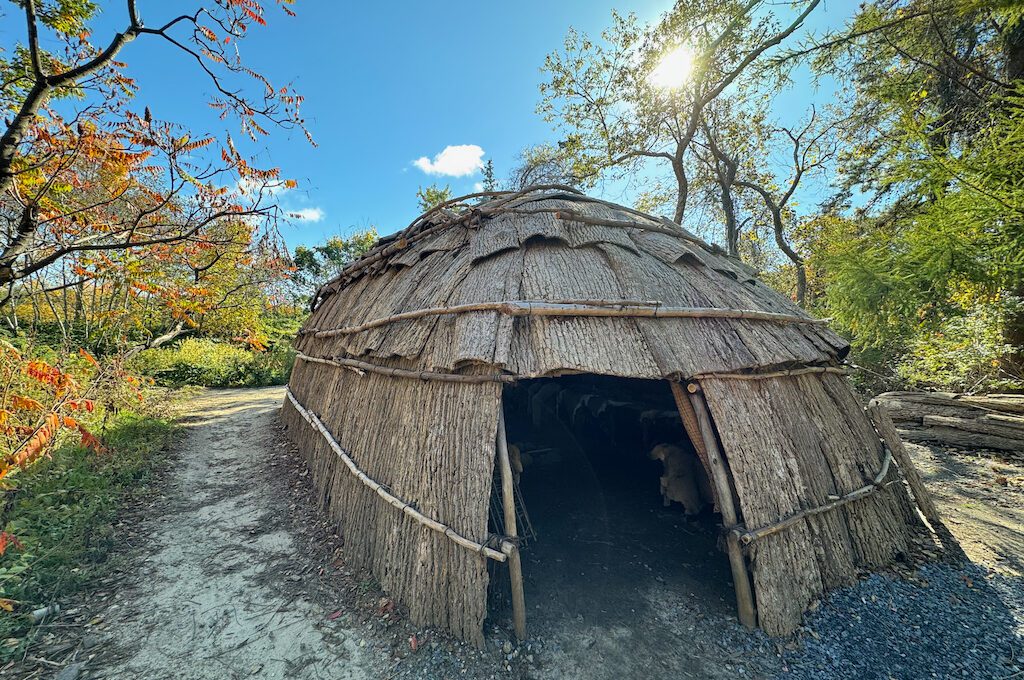
The Wampanoag people, the original inhabitants of this region, played a pivotal role in the early interactions with the Pilgrims upon their arrival in 1620. Sustaining generally peaceful relations for several decades, their history comes to life at the Plymouth Patuxet Museum through recreated structures and canoes.
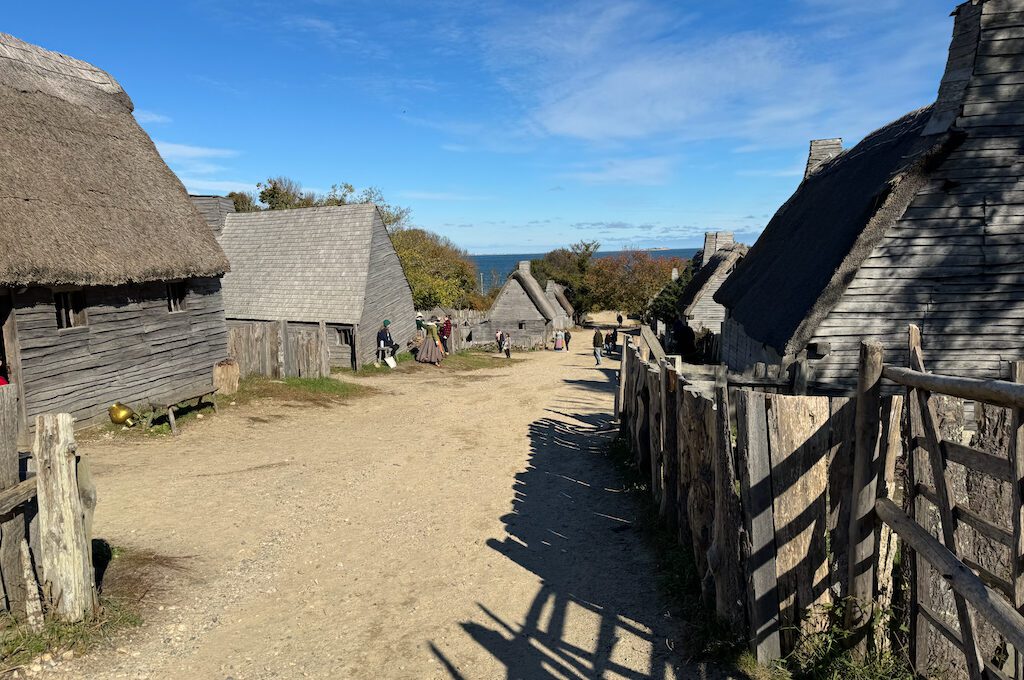
Venturing further, visitors encounter the reimagined Pilgrim Village, transporting them back nearly four centuries. Period-costumed staff populate the village, offering insights into the daily lives of the Pilgrims and providing a rich educational experience. Interactive elements, including demonstrations such as musket firings, add an engaging dimension to this immersive journey into the past.
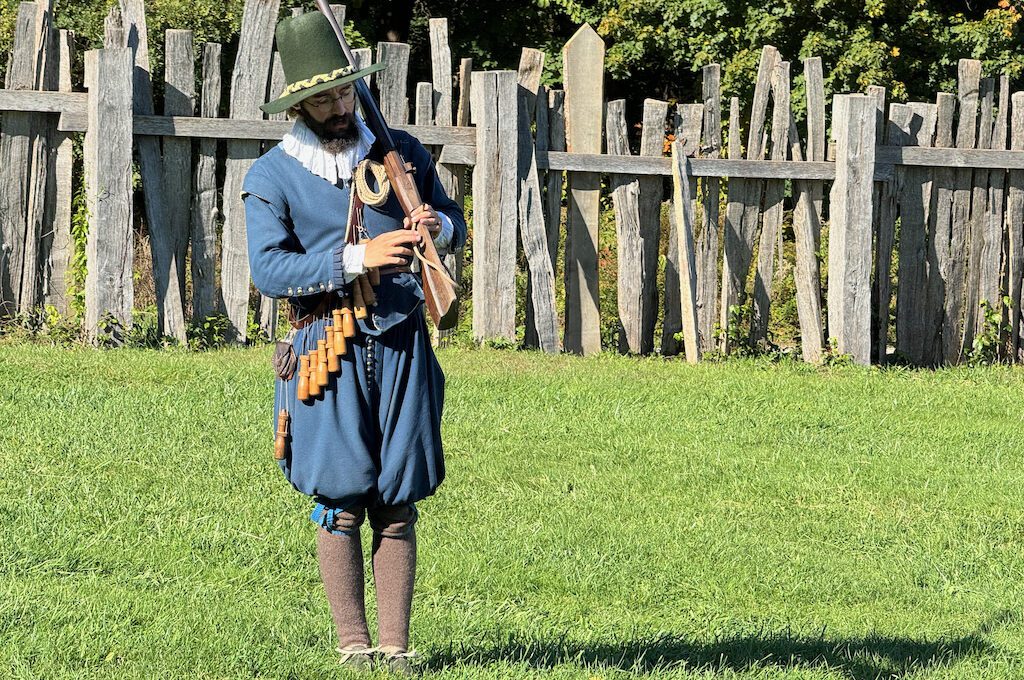
One thing to be aware of is that you can purchase entry for the Mayflower 2, Plymouth Patuxet Museum, and Plymouth Grist Mill as a packaged deal. You can also look into annual membership which we did because it offered us a discount on the Thanksgiving dinner we were doing (more on that below).
Plymouth Grist Mill
The Plymouth Grist Mill stands as a captivating museum, offering a faithful reproduction of a functional grist mill from the 1600s. Notably, it remains operational to this day, providing visitors with a unique glimpse into historical milling practices.
While the on-site gift shop boasts intriguing souvenirs that are worth exploring, the true highlight lies within the mill itself. Stepping inside allows you to witness the inner workings of the mill, providing an immersive experience into the mechanics that were integral to early colonial life.
On select weekends, the mill comes to life as it is actively used to grind corn, with the resulting products available for purchase. This not only offers a fascinating spectacle of a bygone process but also provides an opportunity for visitors to take home a distinctive souvenir—a tangible connection to Plymouth’s rich historical legacy.
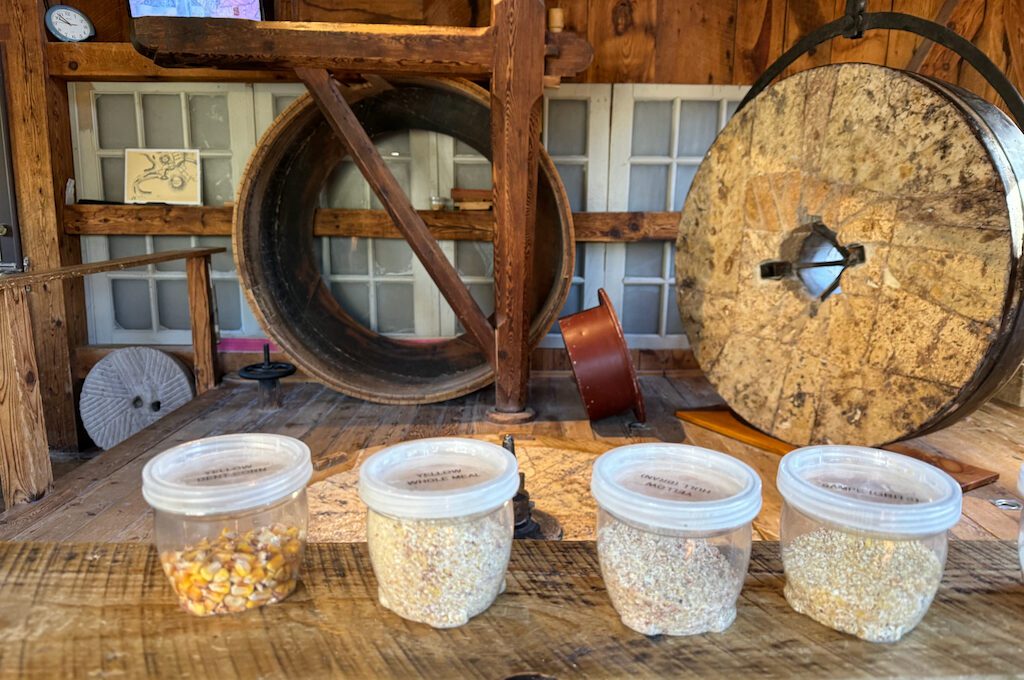
If the mill isn’t actively crushing corn during your visit, there’s still much to glean from a tour of the facility. Engaging with the knowledgeable staff opens up a wealth of information about the various facets of corn, revealing aspects you may not have previously considered.
While this attraction might not be the most exhilarating for everyone, the opportunity to acquire background knowledge and witness the behind-the-scenes workings of a mill proves, at the very least, mildly intriguing. That being said, if time constraints come into play, this might be the one site you consider skipping.
The Pilgrim Hall Museum
The Pilgrim Hall Museum stands out as yet another highly popular attraction, and, personally, I find the architecture of the building quite striking.
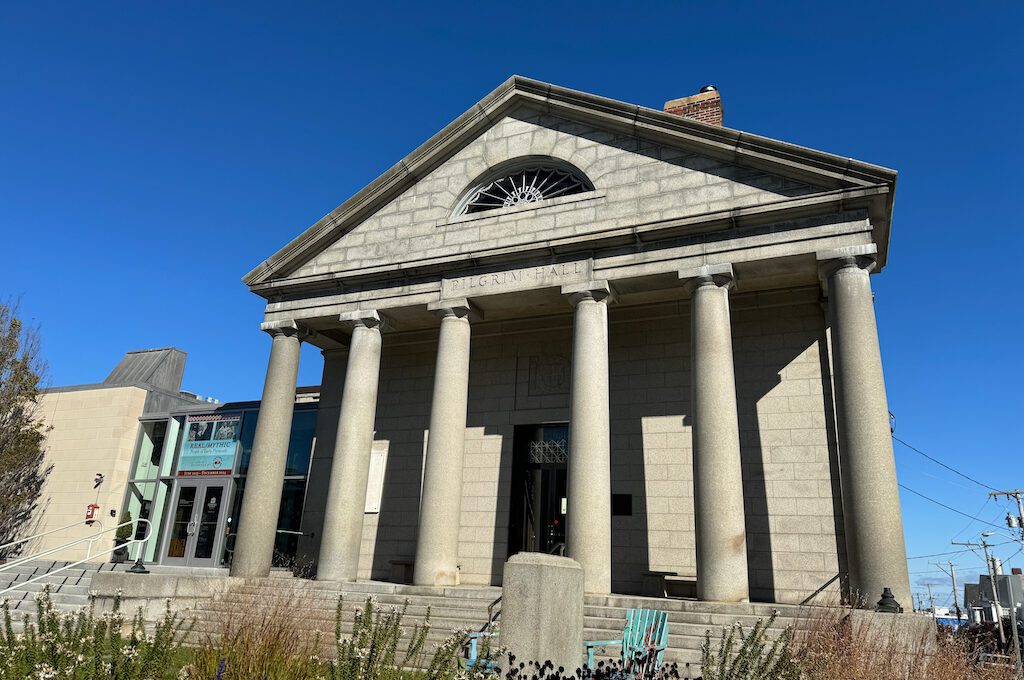
This well-curated museum provides a comprehensive exploration of the Pilgrims and their inaugural voyage. Navigating through its halls, one particular floor captures the essence of the 1600s with an extensive collection of artifacts, undoubtedly my favorite section.
This floor unfolds a trove of historical treasures, showcasing an array of weaponry from the era. From swords and cannons to intricate armor, the display paints a vivid picture of the tools and technologies that shaped the early 17th century. It’s a captivating journey through time, immersing visitors in the material culture of the Pilgrims and their fascinating epoch.
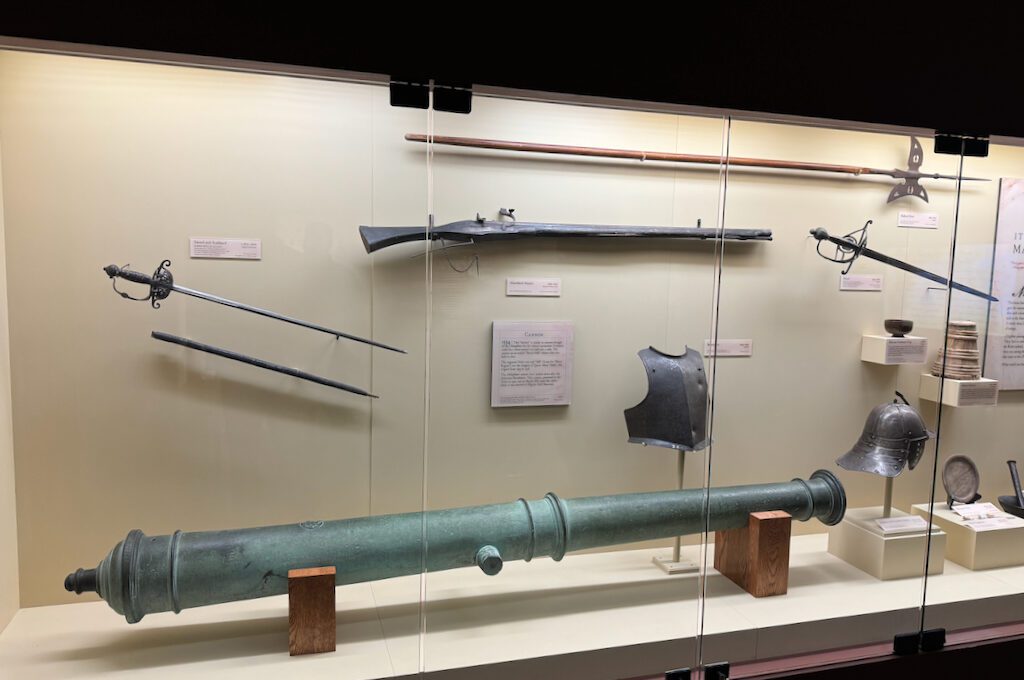
In addition to weaponry, the Pilgrim Hall Museum boasts a captivating assortment of artifacts intimately tied to the original Pilgrims. From furniture and hats to chairs and other intriguing odds and ends, this eclectic collection provides a glimpse into the daily lives of these early settlers.
One of the museum’s main galleries showcases an impressive array of beautiful artwork, featuring expansive paintings that command attention.
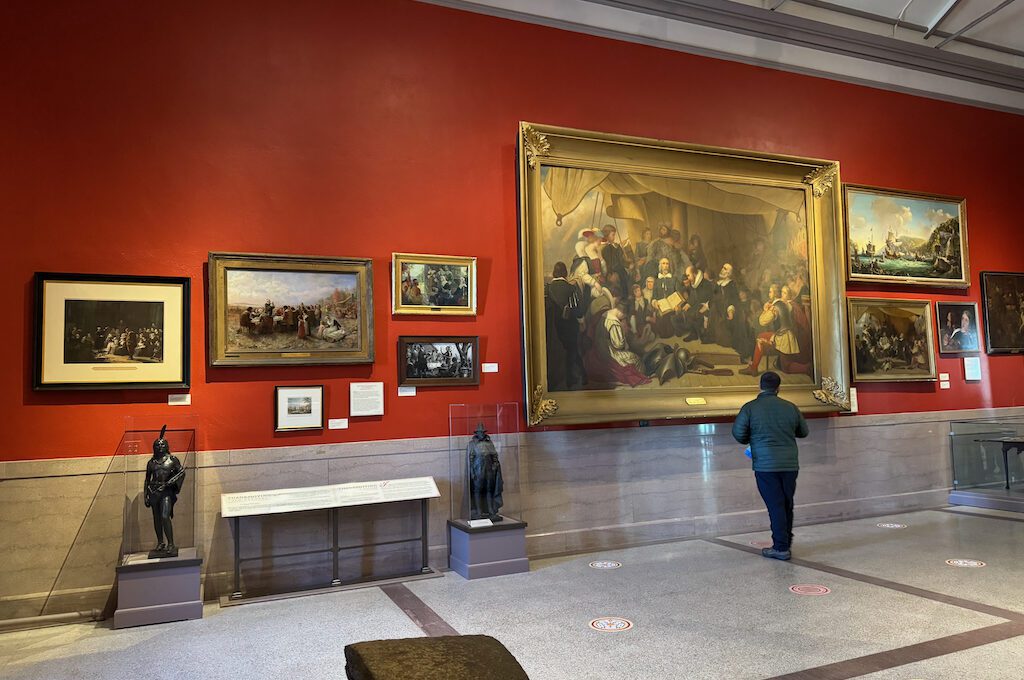
A highlight of this gallery is a piece of mythic rock, a centerpiece attraction that allows visitors to engage with history on a tactile level.
This piece comes from a larger piece that ended up on a historic building’s doorstep, so this particular rock fragment has a storied past. Following its discovery, portions of the rock found their way to prestigious institutions such as the Smithsonian Museum in Washington, DC. The substantial chunk on display at the Pilgrim Hall Museum represents a tangible link to this dispersed and historically significant geological relic.
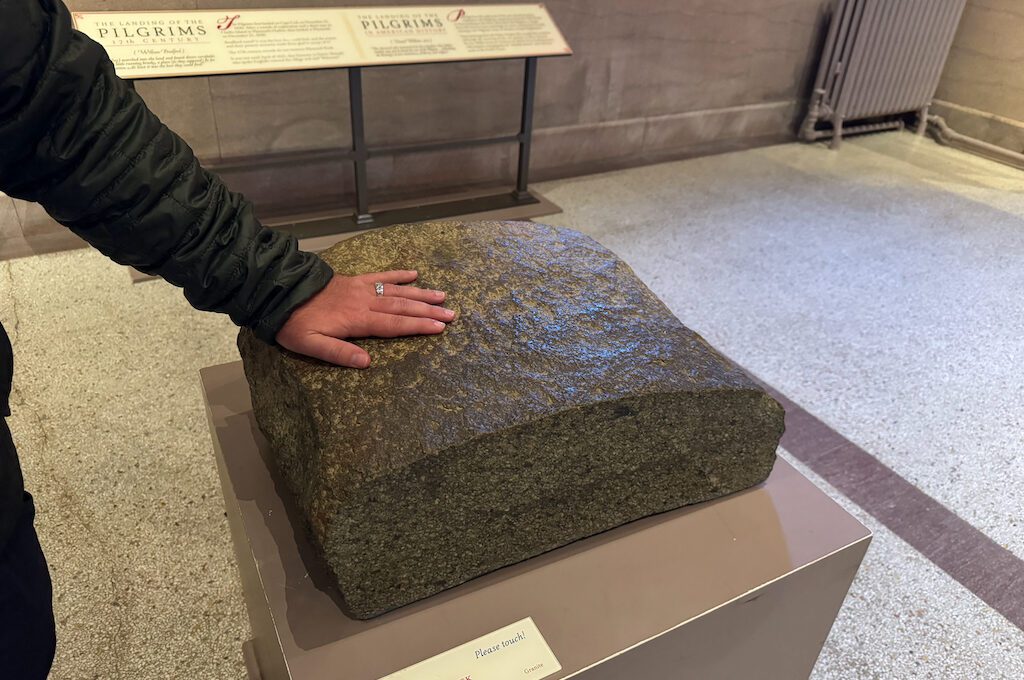
Statues and monuments
Plymouth is adorned with a plethora of monuments and statues, each telling a tale of historical significance.
It’s advisable to get a map to navigate this abundance, given the sheer number of noteworthy installations. Among the striking statues are tributes to figures like Massasoit and William Bradford. And be sure to take a stroll in Brewster Gardens.
One standout monument beckons exploration—the one dedicated to the original pilgrims at Coles Hill Burial Ground. This marks the location of the initial burial ground where pilgrims discreetly interred their deceased during the night, in order to conceal the extent of their losses from potential Native American observers.
While the remains from this site were initially placed in a structure covering Plymouth Rock, a relocation occurred in the 1920s, likely now residing inside or beneath the current structure.
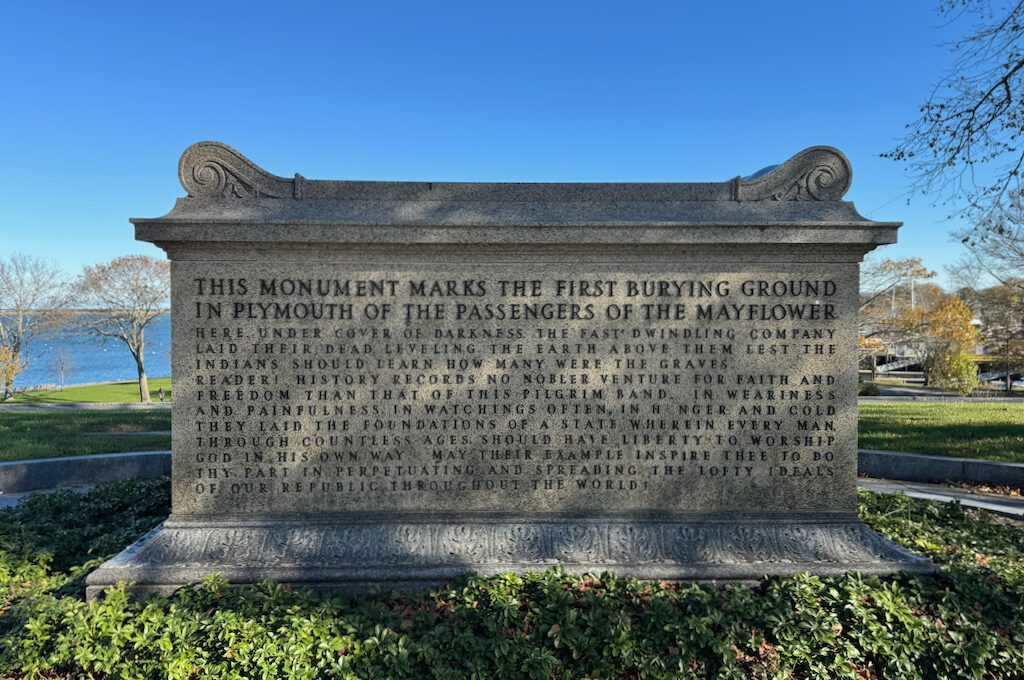
Situated just up the hill from Plymouth Rock, a marker denotes the site of the Pilgrims’ inaugural dwelling. It was within this residence on February 27, 1621, that Miles Standish was elected captain through a majority vote. Moreover, in the vicinity, around April 1, 1621, the historic treaty with Massasoit was forged, establishing a period of enduring peace.
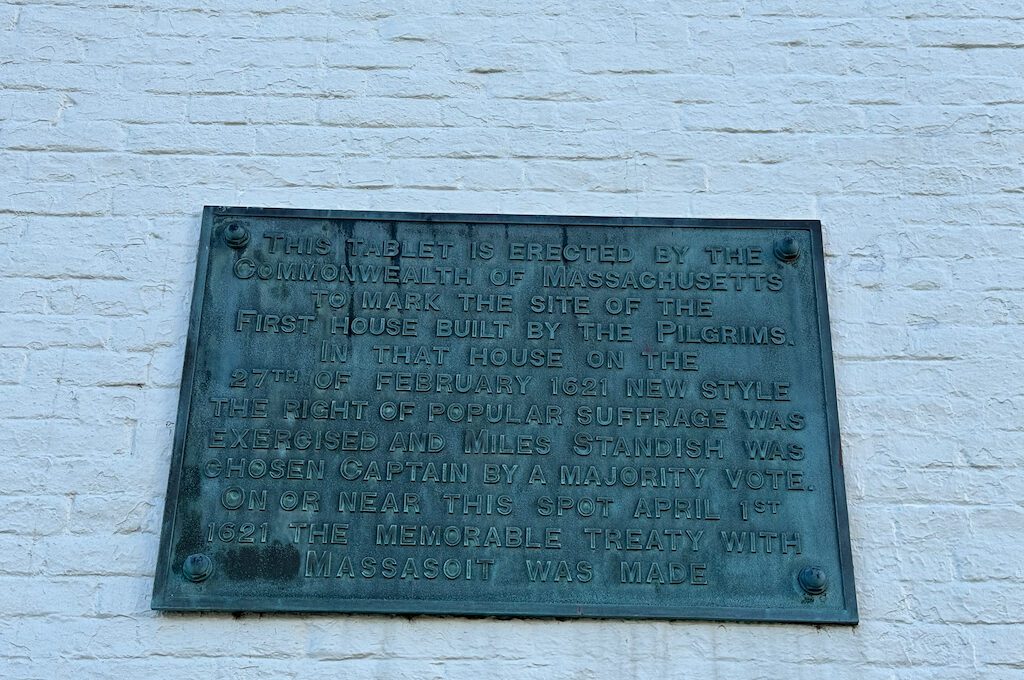
National Monument to the Forefathers
The National Monument to the Forefathers, a towering structure reaching 81 feet (25 m), stands prominently in Plymouth, Massachusetts. Commissioned by the Pilgrim Society and envisioned by Hammatt Billings, this granite tower was dedicated on August 1, 1889. Its purpose is to commemorate the Mayflower Pilgrims and honor their enduring principles of religious freedom and self-governance.
A remarkable feat of engineering, the monument is distinguished as the largest solid granite monument in the United States. Its grand stature and historical significance make it a noteworthy symbol of the Pilgrims’ ideals and a lasting testament to the enduring spirit of the early settlers who laid the foundation for religious and political freedoms in America.
The monument has four allegorical figures at its base, representing Faith, Morality, Education, and Law. These figures are topped by a statue of “The Forefather,” which is a personification of the pilgrims. The inscription on the monument reads: “National Monument to the Forefathers. Erected by a grateful people in remembrance of their labors, sacrifices and sufferings for the cause of civil and religious liberty.”
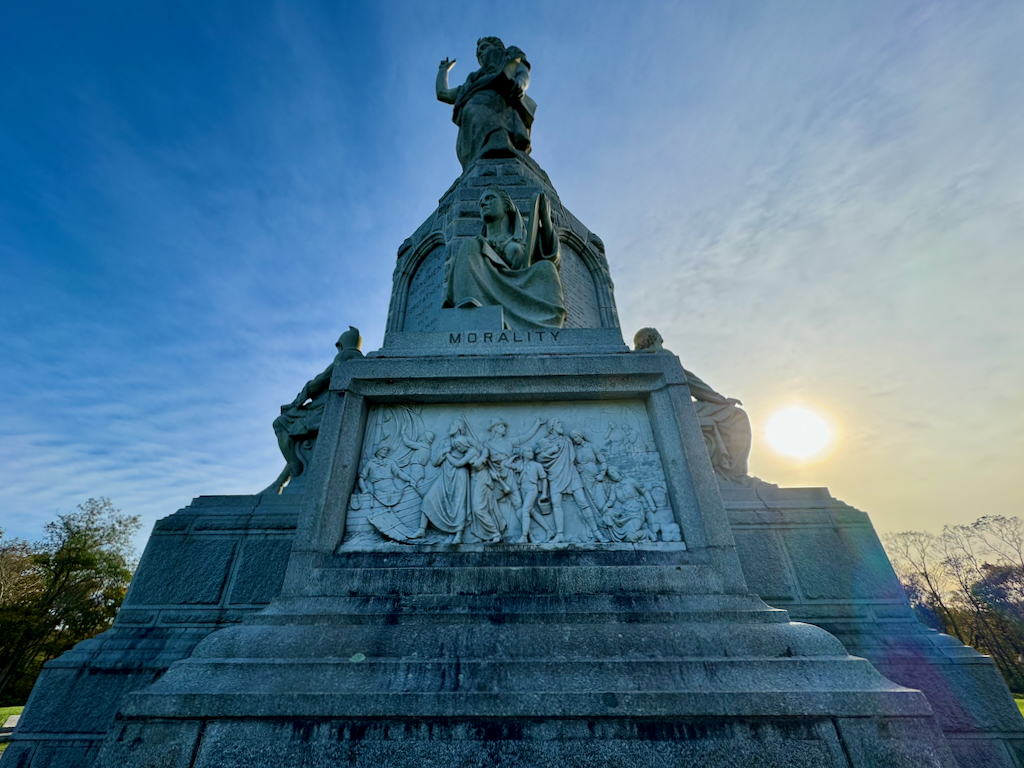
Enjoy your Thanksgiving holiday
As the birthplace of the Thanksgiving holiday, Plymouth naturally draws a significant crowd on the day of festivities. For those seeking a unique Thanksgiving dinner experience, Plymouth offers a variety of options that we had the pleasure of exploring.
One such option is the walk-in buffet hosted at the Plymouth Patuxet Museum. With no need for reservations, visitors can indulge in a Thanksgiving feast either before or after exploring the museum’s grounds.
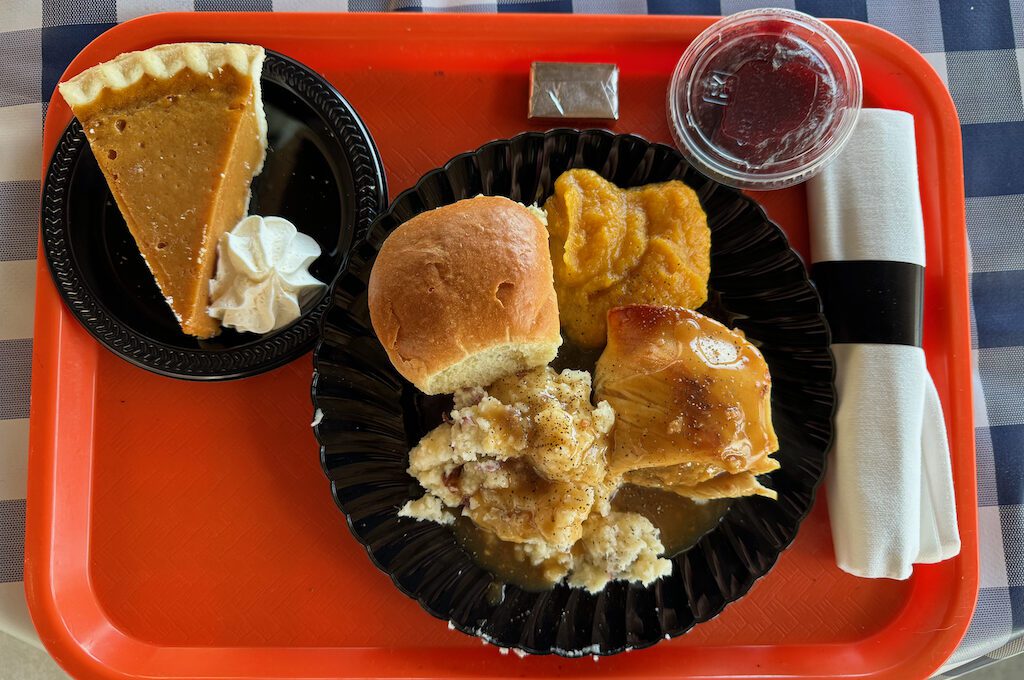
Notably, the museum remains open on Thanksgiving, staffed with interpreters ready to share the Thanksgiving story—a truly distinctive way to celebrate the holiday.
For those inclined towards a more lavish experience, there’s the Story of Thanksgiving Dinner, an upscale option offering a comprehensive Thanksgiving menu. This dining experience goes beyond the culinary delights, weaving in a narrative about the origins of Thanksgiving. The menu draws inspiration from the fare crafted by the Harvard Club during President Lincoln’s time when Thanksgiving gained national prominence.
Lastly, there’s an immersive experience centered around a menu inspired by the 17th century, harking back to the culinary traditions of that era. Plymouth’s Thanksgiving offerings cater to a spectrum of tastes and interests, ensuring a memorable and culturally rich celebration for all.
Enjoy a local restaurant
Plymouth, Massachusetts, boasts a charming array of restaurants, offering diverse culinary experiences.
For enthusiasts of Thai cuisine, a visit to the local Mea Thai Cuisine restaurant comes highly recommended. The flavors and ambiance contribute to a delightful dining experience, showcasing the town’s culinary diversity.

For those with a penchant for burgers, the popular burger joint, KK Burgers, stands out. While slightly on the pricey side, the gastronomic adventure proved to be a satisfying one, with particular commendation for the exceptional service. The combination of delectable offerings and attentive staff makes it a notable stop for burger aficionados exploring Plymouth’s culinary scene.

Final word
As previously mentioned, Plymouth boasts a plethora of smaller historical sites and museums to explore. However, if you’re aiming to spend just one day in Plymouth and want to prioritize the most compelling attractions, this list provides an excellent starting point. Visiting these sites should seamlessly fill your day with captivating historical experiences.
Daniel Gillaspia is the Founder of UponArriving.com and the credit card app, WalletFlo. He is a former attorney turned travel expert covering destinations along with TSA, airline, and hotel policies. Since 2014, his content has been featured in publications such as National Geographic, Smithsonian Magazine, and CNBC. Read my bio.

